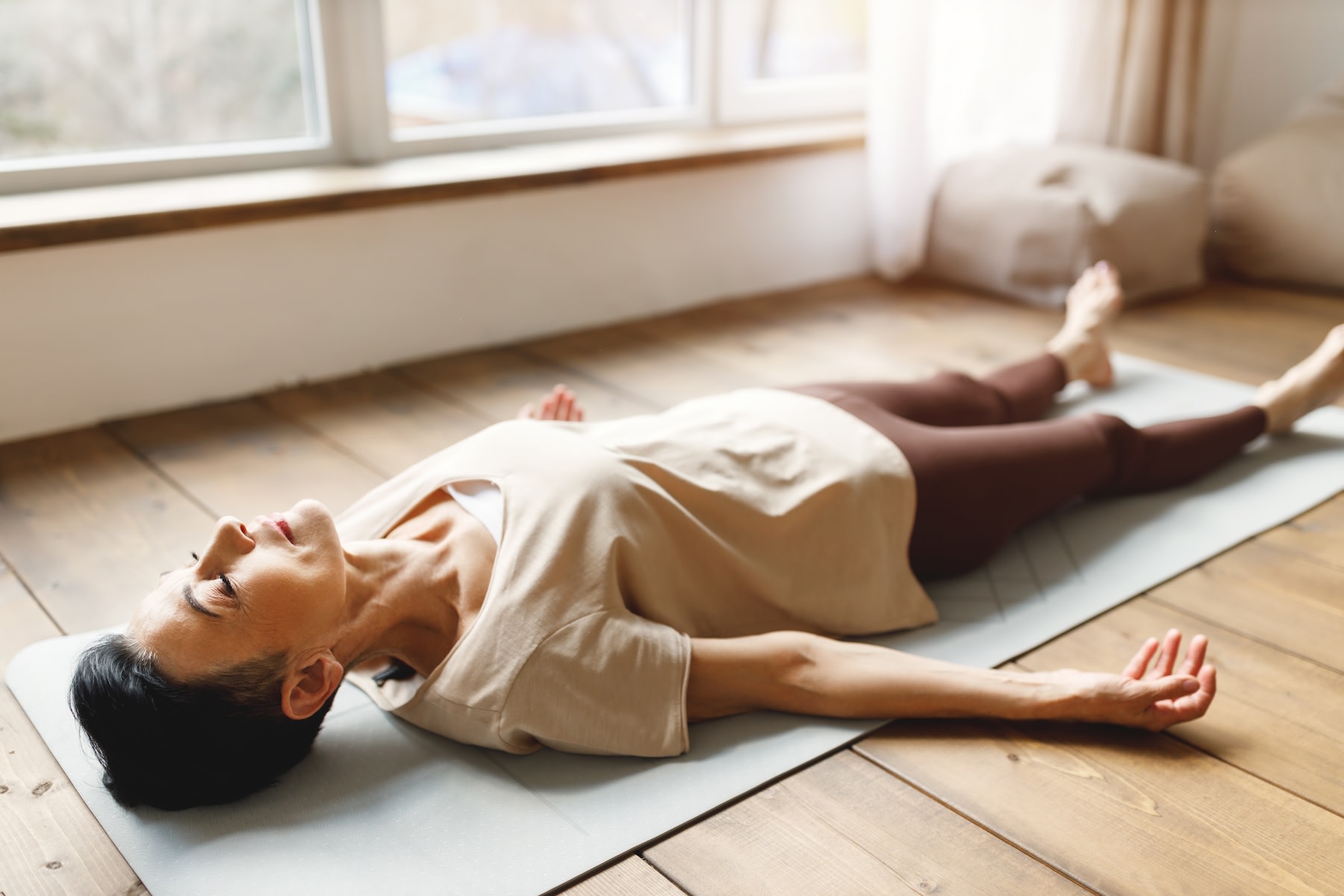
evgenyatamanenko / iStock / Getty Images Plus via Getty Images
Yoga vs. Meditation: The Key Similarities and Differences to Know
The two have a lot in common, but they’re not the exact same thing.
By Michele Ross•
Yoga vs. Meditation: Key Differences
Yoga vs. Meditation: Main Similarities
The Role of Meditation In Yoga
The Benefits of Practicing Both Yoga and Meditation
The Takeaway
Yoga and meditation are two ancient, research-backed, highly popular practices that promote everything from less stress and better sleep to improved self-compassion and a greater sense of inner peace. And while many benefits and aspects of these two modalities overlap, they’re not exactly interchangeable.
Discover more ways to reach your goals with Peloton
So when it comes to yoga vs. meditation, what distinguishes one from the other? How do the two complement one another, and what are the benefits of practicing both? These questions and more, answered below.
Yoga vs. Meditation: Key Differences
Generally, yoga involves movement whereas meditation tends to be still. You can think of yoga (in the modern, westernized sense) as training your body first and foremost, while meditation is a form of training for your mind.
Here are a few main differences to consider when comparing meditation vs. yoga.
Yoga Typically Involves Movement, While Meditation Is Generally Still
According to Peloton instructor Mariana Fernández, both yoga and meditation involve journeying inwards—but they vary in how you do so. Again, the most prevalent difference between yoga and meditation is that the former prioritizes physical poses (asanas) while the latter tends to be still (whether seated or lying down).
“With an asana practice, your awareness is focused on creating shapes and stillness within the different shapes,” Mariana says, in addition to connecting your breath with movement in a fluid way. Most types of yoga typically involve constant motions and flows, with the exception of Savasana at the end of class. Meditation, on the other hand, usually involves staying in a fixed position throughout the entirety of the session.
However, there are, of course, exceptions to these guidelines. For example, slower-paced yoga classes such as yin yoga and restorative yoga will be less dynamic than the likes of vinyasa or yoga with weights—though they’ll still emphasize easing into and holding postures. It’s also possible to do moving meditations, including walking meditations, which naturally incorporate movement but emphasize staying present and mindful of your surroundings and sensations.
They Can Help You Reach Different Goals
Because yoga is typically a more physical practice than meditation, the two modalities also differ in the outcomes they can help you reach.
For example, you might keep up your asana practice to rev up your heart rate, become more flexible, or relieve tightness. On the other hand, perhaps you meditate in the hopes of quieting your mind, recalibrating after a stressful event, or to ease into sleep.
It May Take You Longer to ‘Evolve’ In One Practice Over the Other
Lastly, the time commitment required to achieve a given goal within yoga vs. meditation often differs. Sure, you might feel lighter and brighter walking off your mat after one yoga flow. But certain feats in yoga—like touching your toes or holding a peak pose—can take anywhere from weeks to even years to accomplish.
Some goals associated with meditation—such as promoting healing or reducing anxiety—will also require a long-term practice for the most benefit. However, even a single meditation session could yield some pretty impressive, instantaneous advatanges—including but not limited to enhanced cognitive performance, reduced anger, and a greater sense of peace.
Yoga vs. Meditation: Main Similarities
All things considered, yoga and meditation have more similarities than differences. Here are a few of their key (and extremely powerful!) commonalities.
They Facilitate an Inner Journey
Both yoga and meditation provide an opportunity for you to embark on a journey within, Mariana says. “Oftentimes, folks will use things like running or riding on the Bike as a physical distraction or as a way to move through something, but I think that yoga and meditation have the capacity to [help you] reflect and check in with where you are,” she says.
They Foster Grace and Self-Compassion
Both yoga and meditation provide opportunities for self-compassion, especially in the face of any perceived shortcomings during your practice. For example, “even though you might balance on one foot in Tree Pose one day, you might not be able to do it the next,” Mariana says. “And maybe you’ve had a really heavy day so your morning meditation was a little more of a struggle than the previous day.”
With this in mind, yoga and meditation don’t just train your body and mind, respectively. They also work on your ability to accept where you are in the present moment—limitations and all—and remain kind to yourself.
They’re Always Evolving
Another key similarity between yoga and meditation is that there’s no final destination to reach. “The beauty is that both practices are ever-evolving,” Mariana says. “Even though you might [land] a Headstand, the journey continues. There’s always something above and beyond that you can work or strive towards.”
The same is true with meditation. “Even with meditation, sometimes you’ll think, ‘I did it, I sat still for five minutes.’ Great, now try it for 10,” Mariana continues. In this sense, yoga and meditation both require patience and a beginner’s mindset to advance your practice on deeper, more profound levels.
The Role of Meditation In Yoga
Clearly, yoga and meditation as we know them today share several similarities. But traditionally, the two are even more woven together than you might realize.
“Historically, yoga encompasses physical postures as well as breathwork and meditation,” says Marlynn Wei, MD, a board-certified psychiatrist and author of The Harvard Medical School Guide to Yoga. What’s more, meditation is involved in several of the eight limbs of yoga—an ancient, structured framework for physical and spiritual development—whereas yoga postures or asanas are only expressly included in one of the limbs.
While many people today view yoga solely as a way to develop strength or flexibility, Mariana says it’s “a conduit to get to that meditative state you want to reach.” She sees asanas as a physical aid to help you dial in and believes that yoga can almost always offer opportunities for meditation. This applies no matter if you’re holding Warrior 2 for two minutes, dipping back into Child’s Pose, or finally surrendering into your hard-earned Savasana, where the mental and spiritual benefits can really start to settle in.
“You’re in tune, you’re breathing, and you’re finding [shapes] with your body,” she says. “You start to find a lot more patience with yourself to lead you into maybe the things that you struggle with, like sitting throughout a meditation.”
Of course, there are many ways to partake in both practices—and honor their roots—so you can find what feels right for you.
Can Yoga Replace Meditation?
Dr. Wei reiterates that while a physical yoga practice can offer meditative benefits, it’s unlikely to fully replace the depth of a seated meditation (and vice versa). Still, “each can be a good entry point for different reasons based on individual preferences and responses,” Dr. Wei says.
For example, maybe the mindful elements of meditation sound appealing to you, but the idea of sitting quiet and motionless for several minutes feels daunting or inaccessible. In that case, yoga could serve as a helpful “gateway” to meditation, allowing you to move and breathe through your practice rather than remaining still and fighting what Mariana dubs “ants in your pants.” In this way, you could use yoga to gradually become more comfortable with meditation, preparing you to eventually feel ready and excited to try a traditional seated meditation.
“We all have different obstacles that we find within ourselves that limit us,” Mariana says, “so how can we use this other practice to help us connect and journey inwards?”
The Benefits of Practicing Both Yoga and Meditation
Generally, experts say it’s ideal to add both yoga and meditation into your routine to feel good in your mind and body alike.
“Yoga has a lot of powerful physical health benefits including improving cardiovascular health, flexibility, your immune system, and sleep,” Dr. Wei says. “As a psychiatrist, I also recommend yoga because it improves mood, reduces anxiety, depression, and helps with concentration and focus.”
Meanwhile, seated and/or guided meditations are powerful to reduce anxiety and stress, improve sleep, and boost concentration, Dr. Wei says. Guided meditations—many styles of which you can find on the Peloton App—are especially helpful for beginners and those who get distracted easily.

Peloton App
Access thousands of classes with no equipment needed.
It’s important to note, though, that neither yoga nor meditation will be a valid substitute for personalized guidance from your healthcare provider. Dr. Wei also warns that people suffering from trauma may find yoga or meditation to be triggering, so she advises seeking out gentle, trauma-informed mind-body care to complement current therapies and healing practices.
In case you’d like to complement or combine your yoga and meditation practices, Dr. Wei suggests:
Trying out different types of meditation and yoga to see what resonates most with you
Using yoga as a moving meditation by staying present and mindful to amplify the mind-body connection
Prioritizing consistency to reap the greatest benefits
Relying on meditation if you have physical limitations
In addition, Mariana advises:
Finding mini meditative moments during yoga, such as while holding a certain pose
Bringing a childlike sense of curiosity to both practices
Staying patient and giving yourself compassion, especially when you’re just starting out or having a rough day
Celebrating every win, big or small
The Takeaway
Yoga is one of the best modalities to unite your mind, body, and spirit, while meditation can have profound effects on your mood, cognition, and beyond. When considering yoga vs. meditation, the truth is that they’re actually more similar than they are different. Both offer opportunities to connect to your inner world, stay present, and practice self-compassion—each of which is no small feat in our day and age.
“Yoga and meditation are evolving, lifelong practices,” Mariana reiterates, “whether you’re moving or journeying inwards and finding a state of contemplation.” She advises giving yourself space and permission to go inwards, discovering beauty and grace in the process instead of striving for a particular destination.
This content is for informational and educational purposes only and does not constitute individualized advice. It is not intended to replace professional medical evaluation, diagnosis, or treatment. Seek the advice of your physician for questions you may have regarding your health or a medical condition. If you are having a medical emergency, call your physician or 911 immediately.
Strengthen your mind-body connection
Enter your email to get articles, expert-backed tips, and updates from Peloton sent to your inbox.
By providing your email address, you agree to receive marketing communications from Peloton.
For more about how we use your information, see our Privacy Policy.














